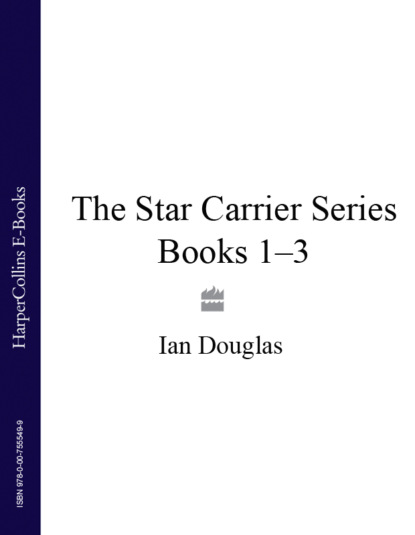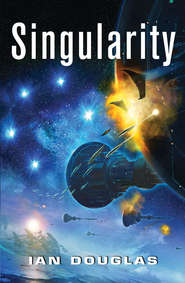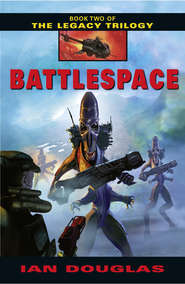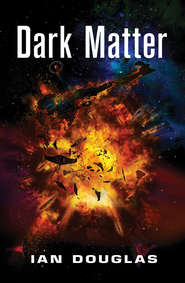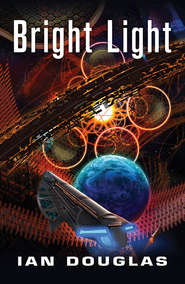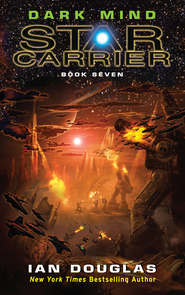По всем вопросам обращайтесь на: info@litportal.ru
(©) 2003-2024.
✖
The Star Carrier Series Books 1-3: Earth Strike, Centre of Gravity, Singularity
Настройки чтения
Размер шрифта
Высота строк
Поля
On the tactical display, a beam of white light snapped out from the icon of the America, connecting the carrier momentarily with an Alpha-class Turusch line battleship—a small asteroid ten times the length of the carrier and bristling with weapon mounts. Its pitted outer surface was pocked and splotched in places by white-hot craters where Confederation weapons had already and repeatedly struck home.
Screens and displays within CIC showed the unfolding fleet action from dozens of different perspectives, the scenes relayed to the battlegroup flag by sensor drones scattered across the battlespace. America’s spinal mount PBP fired a proton beam invisible to the eye or to drone cameras, but it impacted the Turusch shields at energies of up to 1.15 TeV.
Most of that kinetic energy was splashed aside by bent-space shields or electromagnetic screens, but enough leaked through to melt shield projectors set into the asteroid warship’s surface.
And when enough shield projectors were knocked out, the target became vulnerable. …
At this point, Koenig’s role was more that of observer than of military commander. He could suggest strategy and coordination with the other ships of the battlegroup, but Buchanan was captain of the America, the one fighting the ship.
In fact, he thought with a touch of bemusement, the engagement already had become far too big, too fast, and too spread out for any human mind to grasp it, much less control what was happening. America’s AI was running tracking and targeting, firing the weapons, maintaining screens and shields.
All twenty-six of the other Confederation ships in the battlegroup had emerged from Alcubierre Drive and were accelerating now, swiftly building up to combat velocities. The railgun cruiser Kinkaid had fallen into position one hundred kilometers abeam of the America, and was joining her considerable firepower to that of America’s main gun. The Kinky pounded at the asteroid warship, now just eighteen thousand kilometers ahead, with kinetic-kill slugs accelerated at five hundred gravities down its kilometer-long superconductor rail.
“Admiral!” Hughes, the CIC tac evaluator, called out, excited. “We’re picking up fighters. Our fighters, coming up from the planet behind the Trash fleet!”
“How many?” he snapped.
There was an agonizing pause. “Five. Just five. But …”
“Synch their data inks with ours,” Koenig said, interrupting. “Coordinate their attacks with ours.”
“Aye, aye, sir.”
There’d be time to count the losses later … and to mourn them. Right now, the god of battles had offered the Confederation fleet a singular opportunity, and he was going to take the fullest possible advantage of it.
Chapter Seven
26 September 2404
Tactician Emphatic Blossom at Dawn
Enforcer Radiant Severing
0004 hours, TFT
Emphatic Blossom at Dawn, like all of the Turusch, was of three minds.
Literally. The Mind Above, as the Turusch thought of it, was the more primitive, the more atavistic, the original consciousness set that had arisen on the Turusch homeworld perhaps three million of their orbital periods in the past. The Mind Here was thought of as a cascade of higher-level consciousness from the Mind Above, more refined, sharper, faster, and more concerned with the song of intellect.
And the Mind Below was more recent still, an artifact of both Turusch and Sh’daar technology, a merging of Minds Here into a single, more-or-less unified instrumentality.
For Emphatic Blossom, the Mind Above, a shrill demand almost beyond reason, screamed, “Kill!” The Mind Here, analyzing the data coming through the artificial awareness of the Enforcer Radiant Severing, echoed the demand to kill, modifying it with sensory data and intelligence flowing through its linkages with the ship. “Kill,” yes, but with an awareness that the Turusch fleet was now caught between two separate and rapidly closing tentacles of enemy force, that the fleet was caught in a crossfire that seriously hampered its maneuverability and limited its tactical options. There was a distinct possibility of gaining an important advantage if the enemy carrier vessel could be crippled or destroyed.
But the Mind Below carried a different message entirely.
“There are strategic considerations that take precedence beyond the tactical,” Blossom’s Mind Below was saying. “The Sh’daar Seed requires that we withdraw.”
“Threat!” cried the Mind Above. “Kill!”
“The prime orders have not yet been fulfilled,” replied the Mind Here. “Enemy ground forces remain on the objective world, as do the nonmilitary components. These should be eliminated before we withdraw.”
“The ground forces will soon be withdrawn. This is the judgment of the Sh’daar Seed. The prime orders will be fulfilled.”
“Threat!” cried the Mind Above. “Kill!”
“But we can yet inflict severe damage on the enemy,” the Mind Here insisted. “Our sensors have identified no fewer than twelve major vessels in the alien fleet massing greater than twenty-eight thousand g’ri, including their fighter carrier. Destruction of those vessels would seriously weaken the enemy’s ability to mount a counter-offensive against Turusch fleet elements and bases within the sector.
“And the Sh’daar Seed, as ever, circulates plans within plans. When the enemy reaches the Bright One, all of the enemy ships shall be destroyed, and their homeworld left defenseless.”
“Threat!” cried the Mind Above. “Kill!”
The Turusch tactician considered the matter further, then agreed, Mind Below and Mind Here slipping into harmony. It had to, since the Sh’daar Seed’s suggestions took precedence even over the judgment of a tactician.
Still, it would be extremely difficult for the Turusch fleet to extricate itself without suffering further significant damage. The enemy carrier and several other vessels were concentrating their fire on the Radiant Severing, and other vessels of the fleet were being pounded by enemy fighters.
Emphatic Blossom at Dawn could not directly refuse the Seed’s suggestion—such a choice was literally and physically impossible—but it did have a great deal of latitude in how it carried out the Seed’s suggestions.
The heart of the enemy’s offensive capability was their carrier. Destroying that vessel would be the key to extracting the Turusch battle fleet from this pocket.
CIC, TC/USNA CVS America
Eta Boötis IV
0007 hours, TFT
The last of the fighters—SG-92 Starhawks and the older SG-55 War Eagles—were away, VFA-36, the Death Rattlers, flying Combat Air Patrol around the America, the rest lancing at high-G into the Turusch battle fleet. Kiloton nuclear pulses flashed in the distance as warheads blossomed with white fury, reduced to twinkling pinpoints by the distance.
“Three Golf-Mikes inbound,” a CIC technician reported, her voice calm. “Intercept course, detonation in thirty seconds.”
“Countermeasures deployed,” another voice said.
“Escort Farragut moving to intercept,” Craig reported.
Koenig watched the battle developing. The enemy had more ships than the Confederation battlegroup, and a slight technological lead in such areas as gravitics, shields, and beam weaponry, but they’d been bloodied by the fighter strike earlier and were acting in an uncoordinated, almost sluggish manner.
The large vessel ahead—an asteroid, it appeared, partially hollowed out, given massive gravitic drives and mounted with weapons—was probably the enemy command ship. With more and more of the battlegroup’s weaponry concentrating on that one giant ship, it was possible that they were having trouble coordinating their fleet.
Gravitic shields blocked radio waves and lasercom beams. Typically, ships coordinated with one another in combat by flickering one section of their shields off and on while transmitting tightly packaged comm bursts precisely timed with the shield openings. Pile on enough firepower to keep the enemy’s shields up, and you kept him from communicating with other ships as well.
The Turusch fleet was attempting to rush the America … the largest vessel in the Confederation fleet. That’s what I would do, Koenig told himself. As more and more beams and missiles slammed against the Turusch command vessel’s shields, the enemy’s fleet organization became looser, less coherent.
But the enemy ships kept moving forward, sending waves of nuke-tipped missiles and Toad fighters out ahead of the lumbering capital ships.
Even disorganized, that swarm of Turusch ships would be able to overwhelm America’s defenses in fairly short order.
Koenig looked around, momentarily expecting Quintanilla to be there watching, criticizing. The operational orders issued by the Senate Military Directorate while the battlefleet was still gathering off Mars—several hundred megabytes’ worth of detailed instructions—had been very explicit. Koenig was not to risk the star carrier America. She was one of only six ships of her class, and the Military Directorate wanted to minimize the chances of her being lost or badly damaged. Those orders had directed Koenig, if the tactical situation warranted it, to take the America no closer than fifty AUs to Eta Boötis IV, and to direct the battle from there. At all costs, the America was to avoid direct ship-to-ship combat.
Sheer nonsense, of course, the appraisal of armchair admirals and politicians considering the possible course of a naval engagement from the comfort and security of their offices and conference rooms thirty-seven light years away. You could not direct a battle from four hundred light minutes away, not when the situation was over six and a half hours old by the time you received a status update transmission from the rest of the fleet, and with six and a half hours more before your orders crawled back to the fleet. Even worse, Koenig would actually have had to split his small fleet to ensure that America had combat support. If the Turusch detected America, caught her traveling alone, they could launch a long-range fighter strike or send a small detachment of warships to attack the lurking carrier.





